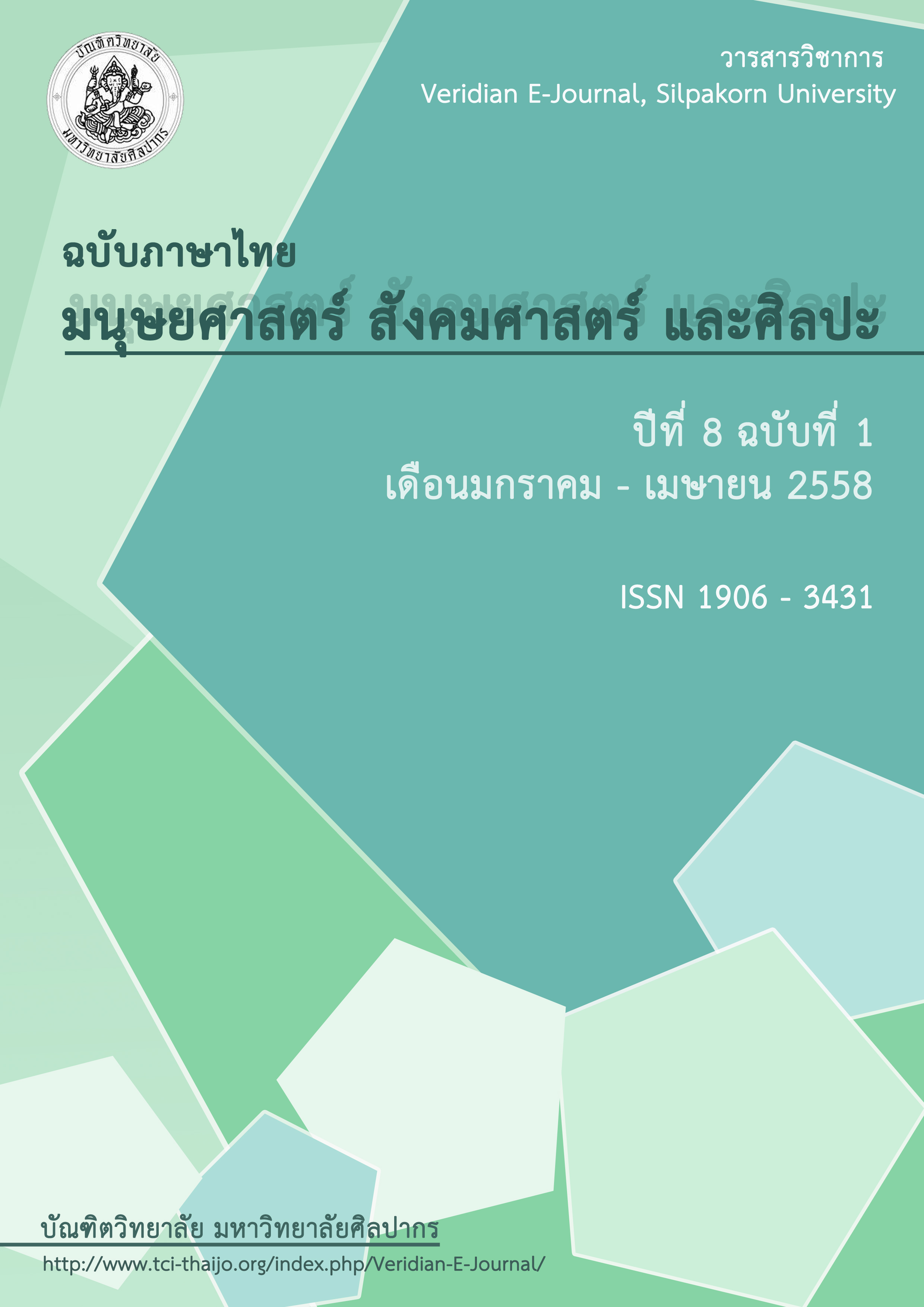การประเมินหลักสูตรศึกษาศาสตรบัณฑิต สาขาวิชาการศึกษาปฐมวัย คณะศึกษาศาสตร์ มหาวิทยาลัยศิลปากร
Main Article Content
Abstract
บทคัดย่อ
การวิจัยครั้งนี้มีวัตถุประสงค์ เพื่อประเมินหลักสูตรศึกษาศาสตรบัณฑิต สาขาวิชาการศึกษาปฐมวัย และเพื่อศึกษาแนวทางการพัฒนาปรับปรุงหลักสูตรศึกษาศาสตรบัณฑิต สาขาวิชาการศึกษาปฐมวัย การวิจัยครั้งนี้ เป็นการวิจัยประเมินผลโดยใช้รูปแบบการประเมินแบบยึดการตัดสินใจซิปป์ไอ (CIPPI Model) ของDaniel L. Stufflebeam ประชากรผู้ให้ข้อมูลคือ ผู้ทรงคุณวุฒิ อาจารย์ บัณฑิต นักศึกษาปัจจุบัน ผู้ใช้บัณฑิต ผู้บริหารคณะศึกษาศาสตร์ ผู้บริหารสถานศึกษา ครูพี่เลี้ยง และเอกสารที่เกี่ยวข้อง เครื่องมือที่ใช้ในการเก็บข้อมูลคือ แบบสัมภาษณ์และแบบสอบถาม การวิเคราะห์ข้อมูลใช้สถิติค่าร้อยละ (%) ค่าเฉลี่ยของประชากร () ค่าความแปรปรวนของประชากร () และการวิเคราะห์เนื้อหา มีผลการวิจัยจำแนกตามองค์ประกอบการประเมิน ดังนี้
1) ด้านสภาวะแวดล้อม (Context) สภาวะแวดล้อมในภาพรวมมีความเหมาะสมอยู่ในระดับมาก เมื่อพิจารณาเป็นรายข้อ พบว่า เรื่องแผนการดำเนินงานของสาขาวิชา อาจารย์ในสาขาวิชาและภาควิชาควรมีการแผนงานพัฒนาอาจารย์โดยการเพิ่มจำนวนอาจารย์ให้เพียงพอ จุดแข็งของสาขาคือ สภาพแวดล้อมทางกายภาพ ส่วนจุดอ่อนของสาขาคือสาขามีจำนวนอาจารย์น้อย ไม่เพียงพอต่อภาระงานสอนเนื่องจากเป็นสาขาที่เปิดใหม่ วัตถุประสงค์ของหลักสูตรเป็นไปตามมาตรฐานของสำนักงานคณะกรรมการการอุดมศึกษา โครงสร้างและเนื้อหาสาระของหลักสูตรสอดคล้องกับจุดประสงค์ของหลักสูตร
2) ด้านปัจจัยนำเข้า (Input) ปัจจัยนำเข้าในภาพรวม มีความเหมาะสมอยู่ในระดับมาก เมื่อพิจารณาเป็นรายข้อ พบว่า องค์ประกอบย่อยได้รับคะแนนประเมินระดับมาก เช่น คุณสมบัติของผู้เรียนและการสอบคัดเลือก คุณสมบัติของอาจารย์/อาจารย์ที่ปรึกษาทางวิชาการ มีข้อเสนอแนะสำหรับบางองค์ประกอบย่อย ได้แก่ ควรเพิ่มจำนวนวัสดุอุปกรณ์สำหรับการค้นคว้า เช่น คอมพิวเตอร์ และระบบงานอินเทอร์เนต
3) ด้านกระบวนการ (Process) กระบวนการในภาพรวม มีความเหมาะสมอยู่ในระดับมาก เมื่อพิจารณาเป็นรายข้อ พบว่า ทุกองค์ประกอบย่อยของการประเมิน ได้รับคะแนนประเมินระดับมาก ได้แก่พฤติกรรมการจัดการเรียนการสอน พฤติกรรมการเรียนรู้ การจัดการเรียนการสอน และการให้บริการและการสนับสนุน มีข้อเสนอแนะคือ ควรจัดให้มีการฝึกประสบการณ์วีชาชีพครูตั้งแต่ภาคการศึกษาต้น
4) ด้านผลผลิต (Product) ผลผลิตในภาพรวมมีความเหมาะสมอยู่ในระดับมาก เมื่อพิจารณาเป็นรายข้อ พบว่า ผลสัมฤทธิ์ทางการศึกษาและคุณลักษณะของบัณฑิต แสดงให้เห็นว่า หลักสูตรได้รับการยอมรับจากสังคมเป็นอย่างดี เห็นได้จากภาวะการงานทำของบัณฑิต นอกจากนี้ ผู้ใช้บัณฑิตยังแสดงระดับความพึงพอใจต่อบัณฑิตในระดับมากทุกด้าน
5) ด้านผลกระทบ (Impact) กระทบในภาพรวม มีความเหมาะสมอยู่ในระดับมาก เมื่อพิจารณาเป็นรายข้อ พบว่า ผู้ใช้บัณฑิตมีความพึงพอใจต่อผลการปฏิบัติงานของบัณฑิตในระดับมาก มีข้อเสนอแนะคือ บัณฑิตควรประเมินผลงานของตนเองและปรับปรุงอย่างต่อเนื่อง
โดยสรุป หลักสูตรศึกษาศาสตรบัณฑิต สาขาวิชาการศึกษาปฐมวัย คณะศึกษาศาสตร์ มหาวิทยาลัยศิลปากร เป็นหลักสูตรที่มีคุณภาพหรือมีผลผลิตตามวัตถุประสงค์ในระดับมาก สมควรที่จะดำเนินการต่อไป เพียงแต่ต้องปรับปรุงองค์ประกอบย่อยบางประเด็นเพื่อให้มีคุณภาพมากขึ้น
คำสำคัญ : การประเมินหลักสูตร การศึกษาปฐมวัย
Abstract
The purpose of this research aims to evaluate Bachelor of Education program in Early Childhood Education and study the development of Bachelor of Education program in Early Childhood Education. This research was evaluated by using the CIPPI model based on Stufflebeam’s decision-making approach. The respondents were experts, lecturers, graduates, current students, employers/advisors, administrators to the Faculty of Education, administrators to the schools and school supervisors. The instruments used to collect data were interviews and questionnaires. The data were analyzed by descriptive statistics, percentage (%) mean (), standard deviation () and content analysis. The results included the following:
1) Context: The context in general was appropriate at the high level. When each item was considered, it was found that for the action plan of the program, the lecturers working for both the section and the department should set up plans for teacher development by increasing the numbers of lecturers. The strength was physical environment. Its weakness was the lacks of lecturers. The curriculum objectives were based on the standards of Office of the Higher Education Commission. The structure and content of the curriculum related to the objectives of the curriculum.
2) Input: The input was generally appropriate at the high level. When each item was considered, it was found that the following items were scored at the high level: students’ qualifications/entrance exam, the characteristics’, lectures and advisors. There were some suggestions for a number of the following physical factors for education should be increased: computers and internet system service.
3) Process: The process in general was appropriate at the high level. When each item was considered, the respondents showed their satisfaction with all of the items at the high level. Those included lecturers’, instruction, students’, learning behaviors, instructional management and services and supports. They suggested professional practice in first semester.
4) Product: The product in general was highly appropriate. When each item was considered, having investigated the graduates’, working status or further studies, the research found that the curriculum of the B.Ed. program had been well recognized among people. Moreover, employers or advisors also showed their satisfaction with the graduates at a high level.
5) Impact: The impact in general was highly appropriate. When each item was considered, it was found that the graduates’ employees were highly satisfied with the graduates’ performance. They suggested promoting self-evaluation and continuous improvement among graduates.
In conclusion, the curriculum evaluation of bachelor of education program in Early Childhood Education, Faculty of Education, Silpakorn University clearly showed its value and accountability in accordance with its objectives. A further implementation of the curriculum was recommended on condition that some items should be improved.
Keywords: Curriculum Evaluation, Early Childhood Education
